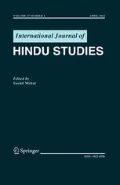References Cited
Āraṇya, Hariharānanda. 1983 [1963, rev. eds. 1977, 1981]. Yoga Philosophy of Patañjali (trans. P. N. Mukerji). Albany: State niversity of New York Press.
Arya, Pandit Usharbudh. 1986. Yoga-Sūtras of Patañjali with the Exposition of Vyāsa: A Translation and Commentary. Volume 1: Samādhipāda. Honesdale: Himalayan Institute.
Bhāratī, Swāmī Veda. 2001. Yoga-Sūtras of Patañjali with the Exposition of Vyāsa: A Translation and Commentary. Volume 2: Sādhanapāda. Delhi: Motilal Banarsidass.
Bhattacharya, Ram Shankar, ed. 1963. Pātañjala-Yogadarśam. Varanasi: Bharatiya Vidya Prakasan.
Bhattacharyya, Krishnachandra. 1956. Studies in Philosophy (ed. Gopinath Bhattacharyya). Volume 1. Calcutta: Progressive Publishers.
Churchland Paul M. (1979) Scientific Realism and the Plasticity of Mind. Cambridge University Press, Cambridge
Churchland, Paul M. 1988 [1984]. Matter and Consciousness: A Contemporary Introduction to the Philosophy of Mind. Cambridge: The MIT Press.
Churchland, Paul M. 1998. “Betty Crocker’s Theory of Consciousness.” In Paul M. Churchland and Patricia S. Churchland, On the Contrary :Critical Essays, 1987–1997, 113–22. Cambridge: The MIT Press.
Churchland Paul. (2007) Neurophilosophy at Work. Cambridge University Press, Cambridge
Damasio, Antonio. 2010. Self Comes to Mind: Constructing the Conscious Brain. New York: Pantheon Books.
Dennett, Daniel C. 1991. Consciousness Explained. Boston: Little, Brown and Co.
Descartes[, René]. 1968. Discourse on Method and the Meditations (trans. F. E. Sutcliffe). London: Penguin Books.
Eagleman, David. 2011. Incognito: The Secret Lives of the Brain. New York: Pantheon Books.
Eccles, Sir John and Daniel N. Robinson. 1985 [1984]. The Wonder of Being Human: Our Brain and Our Mind. Boston: Shambhala Publications.
Ey, Henri. 1978 [1963, enlarged ed. 1968]. Consciousness: A Phenomenological Study of Being Conscious and Becoming Conscious (trans.John H. Flodstrom). Bloomington: Indiana University Press.
Gazzinga, Michael S. 2011. Who’s In Charge: Free Will and the Science of the Brain. New York: Harper Collins.
Gregory, Richard L., ed. 1987. The Oxford Companion to the Mind. Oxford: Oxford University Press.
Larson, Gerald James. 1983. “An Eccentric Ghost in the Machine: Formal and Quantitative Aspects of the Sāṃkhya-Yoga Dualism.” Philosophy East and West 33, 3: 219–33.
Larson, Gerald James. 1987. “Introduction to the Philosophy of Sāṃkhya.” In Gerald James Larson and Ram Shankar Bhattacharya, eds., Sāṃkhya: A Dualist Tradition in Indian Philosophy, 1–103. Volume 4 of the Encyclopedia of Indian Philosophies (gen. ed. Karl H. Potter). Princeton: Princeton University Press.
Larson, Gerald James. 1992. “Krishna Chandra Bhattacharyya and the Plurality of Puruṣas (Puruṣa-bahutva) in Sāṃkhya.” Journal of the Indian Council of Philosophical Research 10, 1: 93–104.
Larson, Gerald James. 1994. “Is South Asian Yoga ‘Philosophy,’ ‘Religion,’ Both or Neither.” In Ugo Bianchi, ed., The Notion of “Religion” in Comparative Research: Selected Proceedings of the XVI IAHR Congress, 261–70. Rome: “L’Erma” di Bretschneider.
Larson, Gerald James. 1995. “Classical Yoga Philosophy and Some Issues in the Philosophy of Mind.” Religious Studies and Theology 13–14, 1:36–51.
Larson, Gerald James. 2003. “The Anthropic Principle: Life, Cosmos and Consciousness.” In, Philosophy and Science: An Exploratory Approach to Consciousness (Papers Read at Seminar held at the Ramakrishna Mission Institute of Culture, Kolkata, India, on 8 and 9 February 2002), 182–86. Calcutta: Ramakrishna Mission Institute of Culture.
Larson, Gerald James. 2007 [2000]. “Classical Yoga Philosophy and Some Issues in the Philosophy of Mind.” In, Concepts of Knowledge: East and West (Papers from a Seminar held from 4 January to 10 January, 1995, at the Ramakrishna Mission Institute of Culture), 132–51. Calcutta: Ramakrishna Mission Institute of Culture.
Larson, Gerald James. 2009. “Differentiating the Concepts of ‘yoga’ and ‘tantra’ in Sanskrit Literary History.” Journal of the American Oriental Society 129, 3: 487–98.
Larson, Gerald James. 2011 [2008]. “Part One: The Philosophy of Yoga.” In Gerald James Larson and Ram Shankar Bhattacarya, eds., Yoga: India’s Philosophy of Meditation, 21–148. Volume 12 of the Encyclopedia of Indian Philosophies (gen. ed. Karl H. Potter). Delhi: Motilal Banarsidass.
Larson, Gerald James. 2012a. “Pātañjala Yoga in Practice.” In David Gordon White, ed., Yoga in Practice, 73–96. Princeton: Princeton University Press.
Larson, Gerald James. 2012b [1969, rev. ed. 1979]. Classical Sāṃkhya: An Interpretation of Its History and Meaning. Delhi: Motilal Banarsidass.
Larson, Gerald James and Ram Shankar Bhattacharya, eds. 1987. Sāṃkhya: A Dualist Tradition in Indian Philosophy. Volume 4 of the Encyclopedia of Indian Philosophies (gen. ed. Karl H. Potter). Princeton: Princeton University Press.
Larson, Gerald James and Ram Shankar Bhattacharya, eds. 2011 [2008]. Yoga: India’s Philosophy of Meditation. Volume 12 of the Encyclopedia of Indian Philosophies (gen. ed. Karl H. Potter). Delhi: Motilal Banarsidass.
Lycan, William G., ed. 1990. Mind and Cognition: A Reader. Oxford: Basil Blackwell.
Maas, Philipp André. 2006. Samādhipāda: The First Chapter of the Pātañjalayogaśāstra for the First Time Critically Edited. Geisteskultur Indiens. Texte und Studien 9. Aachen: Shaker Verlag.
Popper, Karl R. and John C. Eccles. 1983 [1977]. The Self and Its Brain: An Argument for Interactionism. London: Routledge and Kegan Paul.
Priest, Stephen. 1991. Theories of the Mind. Boston: Houghton Mifflin.
Putnam, Hilary. 1991. “The Nature of Mental States.” In David M. Rosenthal, ed., The Nature of Mind, 197–203. Oxford: Oxford University Press.
Rorty, Richard. 1970. “In Defense of Eliminative Materialism.” The Review of Metaphysics 24, 1: 112–21.
Rorty, Richard. 1991a. Objectivity, Relativism and Truth. Volume 1: Philosophical Papers. Cambridge: Cambridge University Press.
Rorty, Richard. 1991b. “Persons Without Minds.” In David M. Rosenthal, ed., The Nature of Mind, 268–86. Oxford: Oxford University Press.
Rosenthal, David M., ed. 1991. The Nature of Mind. Oxford: Oxford University Press.
Rukmani, T. S., ed. and trans. 1981–89. Yogavārttika of Vijñānabhikṣu. 4 volumes. Delhi: Munshiram Manoharlal.
Searle John. (1984) Minds, Brains and Science. Harvard University Press, Cambridge
Searle John R. (2004) Mind: A Brief Introduction. Oxford University Press, Oxford
Smith, Anthony. 1984. The Mind. Harmondsworth: Penguin Books.
Woods, James Haughton, trans. 1914. The Yoga-System of Patañjali. Harvard Oriental Series l7. Cambridge: Harvard University Press.
Author information
Authors and Affiliations
Corresponding author
Rights and permissions
About this article
Cite this article
Larson, G.J. Materialism, Dualism, and the Philosophy of Yoga. Hindu Studies 17, 181–219 (2013). https://doi.org/10.1007/s11407-013-9140-8
Published:
Issue Date:
DOI: https://doi.org/10.1007/s11407-013-9140-8

